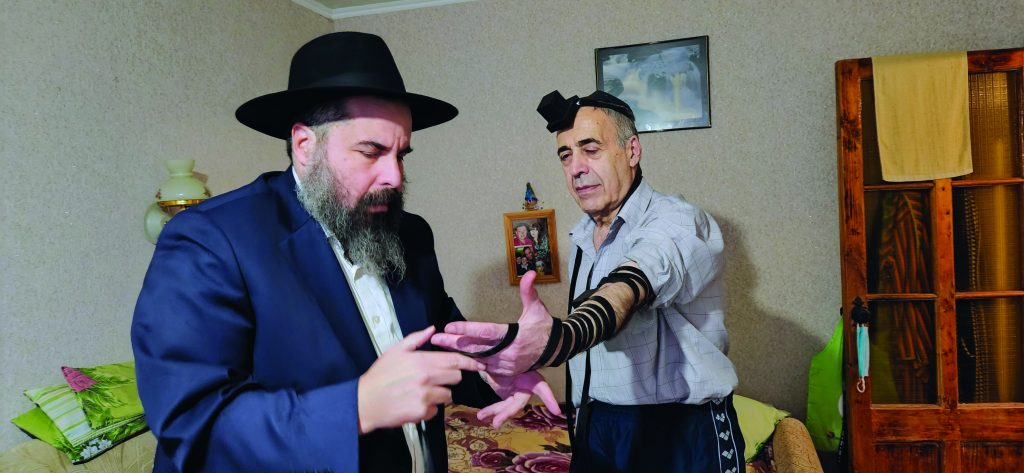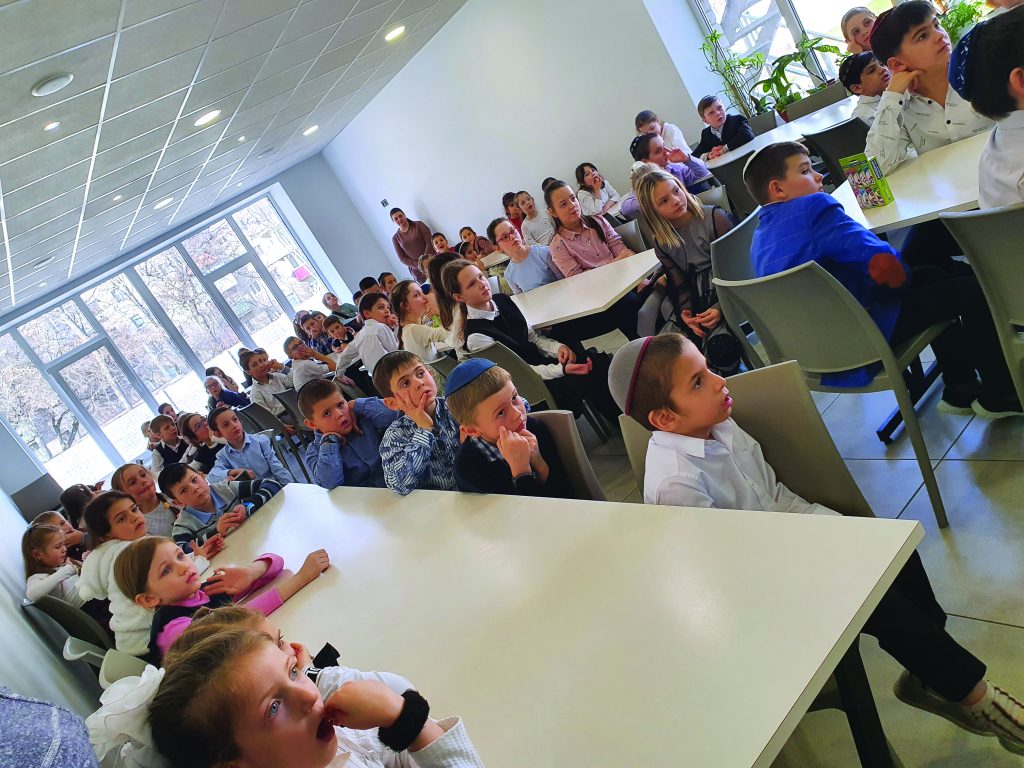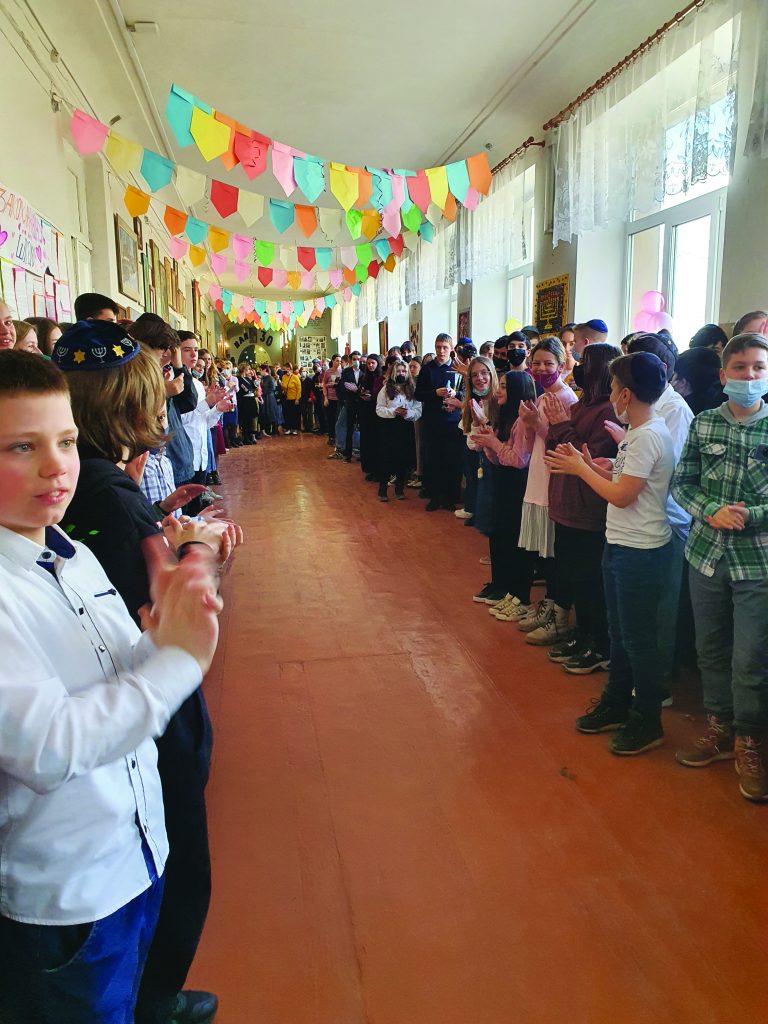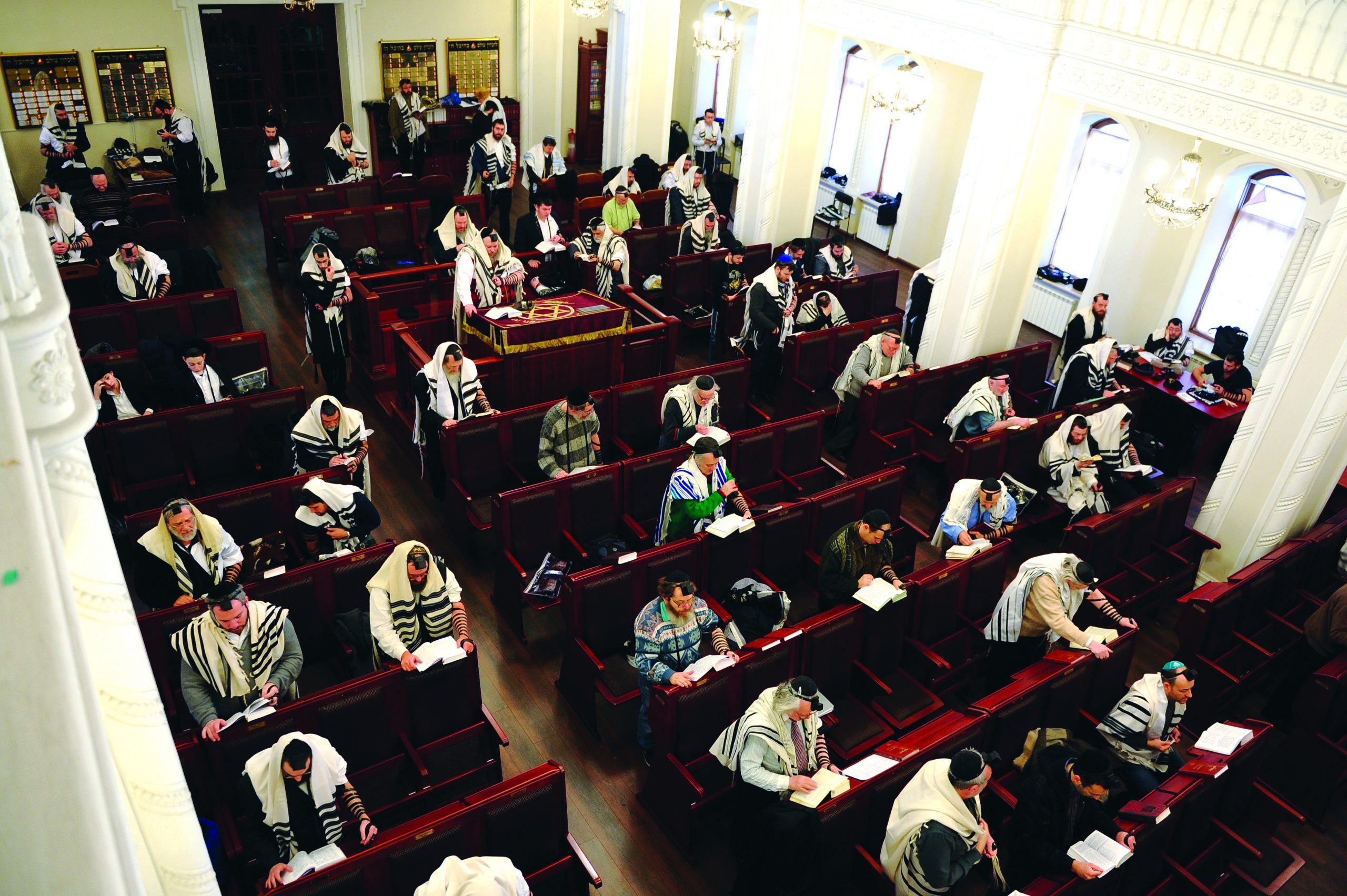The Torah Revival in Ukraine
When the war broke out in Ukraine, many were surprised to discover the existence of a growing and vibrant teshuvah movement in Ukraine. How did it come about?
Call it a knockout punch by a Kyiv rabbi.
A decade ago, twelve-year-old Constantin Vaskovskiy, an age-group boxing champion and a member of a typical Jewish family in his native Ukraine, was invited to a Jewish camp by a Chabad shaliach.
Vaskovskiy wasn’t interested.
“I needed to train” for future matches. “Boxing was my whole life,” says Vaskovskiy, now twenty-three.
The shaliach who had befriended his family convinced Vaskovskiy to attend the end-of-summer program, a seven-and-a-half-hour trip from Kyiv.
Still, the tween was skeptical. “I thought religious people were boring.”
Instead, at the three-week camp, he met counselors from the US who broke the stereotype. “They were so cool. They knew how to laugh.”
At the camp, Vaskovskiy began a process that led to his becoming an Orthodox Jew. He began davening regularly, wearing a kippah and tzitzit, keeping Shabbat, and adopting a kosher diet.
At the camp, he underwent a brit milah. His own choice. He called his mother to discuss the circumcision. “My mom said, ‘No way!’” He did it anyway. “Me and another five guys.”
At the camp, he started using the Hebrew name Aron. His choice again. His mother, who was proudly Jewish but was raised in a secular home, and his father, who was not Jewish, had not given him a Hebrew name. The campers had learned about Aharon HaKohen. “I liked how the name sounded,” he says.
Back home, Aron was “excited about Judaism.” He insisted on eating strictly kosher. “I’m not cooking [separately] for you,” his mother said. She ended up preparing kosher meals for her son.
He insisted on enrolling in a Jewish school. “My Mom said, ‘No way!’” He ended up dorming in a Jewish school in Dnipro.
Eventually, he spent four years studying Torah in Israel and received semichah. His mother took on an observant lifestyle, and his older brother, who had also originally been resistant to an Orthodox life, became a Chabad shaliach in Ukraine.
Today, Aron is thoroughly Orthodox, but he has not forgotten his Ukrainian roots. Temporarily in the US, Aron, who wears a light-brown “Dnipro” yarmulke on his head, currently lives in the Crown Heights section of Brooklyn. [Dnipro is Ukraine’s fourth-largest city.]
Aron’s story is of course unique, but as a Jew from Ukraine, a newcomer to a life of Torah and mitzvot, he has plenty of company. He knows “a lot of ba’alei teshuvah” from similar backgrounds. “Everyone has a different story,” says Aron.
Which is largely the story of post- Communist Ukrainian Jewry.
Since Communism fell in his homeland three decades ago and open expression of Judaism became permitted there, the country has filled with Artems and Bohdans and Olenas and Nadiyas who have become ba’alei teshuvah and have taken on Jewish names. They fill the seats of invigorated synagogues and schools, serve as volunteers and paid employees in the Jewish organizations that formed when post-Communism permitted religious life and have embraced the type of Judaism of which their parents and grandparents were deprived by the godlessness of Communism.
By no means have all Ukrainian Jews embraced a Torah lifestyle, but many, the country’s Jewish leaders say, are more respectful, more open to learning about Jewish tradition and more involved in Jewish programming.
There were no more than fifty observant Jews in the country. Today? There are probably between 7,000 and 8,000.
Just as elsewhere behind the former Iron Curtain (in Eastern Europe and the other now-independent republics of the former Soviet Union [FSU]), Ukraine, a land that gave birth to countless Chassidic rabbis and Orthodox shtetls, has experienced a Jewish renaissance—of wider Jewish culture as well as traditional Judaism—since 1991. (These spiritual changes reflect changes in many other parts of society: in politics, the economy, and even in the spelling of the names of several Ukrainian cities, an assertion of Ukrainian individuality—Kiev became Kyiv; Kharkov, Kharkiv; Lvov, Lviv and so on.)
In the aftermath of the breakup of the FSU, the Jewish communities of each of the fifteen republics that became independent nations (as well as the subsequent Jewish revival in each place) were largely treated as a monolith. People abroad spoke of “Russian Jews” and “Soviet Jews” interchangeably, often including those of the entire USSR, many of whom loudly rejected being identified as Russian. Indeed, the various Jewish communities are not identical to each other, and in the years that followed, especially in this last year since Russia’s war against Ukraine began, the distinct nature of Ukraine’s Jewish community and its growth of Torah Judaism have become clearer. Though all the ex-Communist nations share some common features, the Jewish revival in Ukraine is not the same as in Russia, Belarus, Lithuania, et cetera.
“There was absolutely nothing when we got there [in 1990],” at least no open, extant Jewish infrastructure, says Rebbetzin Miriam Moskovitz, a native of Australia who came to Kharkiv with her Venezuelan-born husband, Rabbi Moshe Moskovitz.

Rabbi Moshe Moskovitz, Chabad shaliach for Kharkiv, shows a community member how to don tefillin. Courtesy of Chabad.org
“This was a spiritual desert,” says Dovid Margolin, senior editor at Chabad.org, who has visited Ukraine extensively in the last decade and interviewed many of its residents, as well as its rabbis and rebbetzins. In some communities, there was “nothing on the ground,” except for “a minyan of old men.” The Jews there had little Jewish knowledge, beyond familiarity with the names of some prominent Jews and antisemites of the past, Margolin says. “They also knew about matzah”—even during the darkest days of Communism, many Jews in the FSU had made an effort to obtain a supply of matzah for Passover.
And now?
Ukraine is now home to two generations of Orthodox Jews and a full gamut of Orthodox life. “[Jewish] Ukraine is a different place today than it was thirty years ago,” says Margolin. “A lot has changed.” He points to the successful 2017 presidential candidacy of Volodymyr Zelensky, who in December 2022 was named Time magazine’s Person of the Year. Zelensky’s ethnic identity was a non-issue during the election, which is surprising considering the country’s previous association with antisemitism.
Across Ukraine (as well as its sister Soviet republics), where Communism had flourished during seven decades of atheistic, antisemitic rule, the first blooms of Yiddishkeit were visible in the early 1990s. As tens of thousands of Ukrainian Jews immigrated to freedom in Israel, the United States and other Western countries (whence has come the financial support for the extensive and expensive Jewish programs and sites in Ukraine), the Jews who remained behind in their homeland began to rebuild their own spiritual lives with the growth of a flourishing Jewish community and the establishment of a wide variety of Jewish institutions and organizations in cities big and small.
All this was under the guidance of foreign-born rabbis and their spouses, mostly Chassidic, predominantly Chabad-Lubavitch—some of whom, assigned by the Lubavitcher Rebbe, had arrived in 1990 before the republic achieved its independence—who came to Ukraine as young, freshly ordained yeshivah students and have grown middle-aged; they are now prominent, highly visible and politically influential figures in their respective cities.
This was in a country whose estimated Jewish population of 200,00 to 400,000 (according to various Jewish sources) ranks among the largest in the world; a significant part of Ukraine had lain within the borders of the Russian Empire’s Pale of Settlement, which was home to much of the world’s Jewish population, with Jews having been permitted to reside there for nearly 130 years until World War I.
The signs of rebirth were evident immediately. A 1995 article in the Washington Post described “a brisk revival of Jewish life in Ukraine . . . three years after the Soviet Union’s collapse, synagogues and Jewish schools and social programs are sprouting again in Kyiv, Lviv, Odessa and other cities.”

Children in Kharkiv’s Ohr Avner Jewish School, under the auspices of Rabbi Moshe and Rebbetzin Miriam Moskovitz. Courtesy of chabad.org
Observers of Ukrainian Jewry have witnessed these changes in the country’s Jewish life. According to the best estimates, there were no more than fifty fully observant Jews in the country in 1991. Today? There are probably between 7,000 and 8,000.
How do you find Jews who were afraid to openly identify themselves as Jewish during decades of Communist rule?
One veteran shaliach said he would see “a Yiddishe panim [Jewish face] … on the street, on the tram” and strike up a conversation. Eventually, the initial wariness dissipated; then their interest in Judaism grew. “People saw that Yiddishkeit is not just about a history of persecution. ‘I want to be part of this,’” they told him.
The rabbinic couples who have settled in Ukraine tell a story that is common in the region’s once-Communist countries: of hidden Jews seemingly coming out of the woodwork, of men and women discovering their Jewish roots late in life, of the size of Jewish communities remaining constant no matter how many Jews have left for overseas.
Rebbetzin Moskovitz keeps meeting these people. “New Jews,” she calls them.
Rebbetzin Esther Wilhelm, who came to Zhitomir twenty-eight years ago with her husband Rabbi Shlomo Wilhelm as a Chabad shlichim couple, has transformed the small, “sleepy” town into a vibrant center of Jewish life. Zhitomir now offers a synagogue, an elementary and high school and the Alumim Educational Campus that serves children from troubled homes.
“When we first came to Zhitomir, Jews had no idea what it means to be a Jew,” Rebbetzin Wilhelm says, “They didn’t understand Shabbos or kashrus.”
The couple wanted to put on a Lag BaOmer parade—a common Lubavitch custom—their first year there, “But the people were scared,” she says. “They said: we are going to walk down the street and people are going to see that we are Jewish?”
Zhitomir had its Lag BaOmer parade. “We needed to give them a sense of Jewish pride,” the Rebbetzin says. “Now when we have our Lag BaOmer parades, hundreds of Jews join us walking down the street. They are so proud. There’s been a complete turnaround.”
Because of the danger in Ukraine since the war started in early 2022, the Wilhelms have temporarily relocated to Israel, along with 150 Jews from their community.
Some other Chabad shlichim have also left Ukraine, for safer venues, in the last year, while many have remained there.
Other leaders of Ukrainian Jewry in the last three decades have included:
• Rabbi Mordechai Shlomo Bald, a native of New York, and his wife Sarah, Karlin-Stolin Chassidim based in Lviv. When Rabbi Bald, who mastered the Ukrainian language, first moved to Lviv thirty years ago, he started a school that closed a few years ago and a number of educational programs.
• Rabbi Shlomo Baksht, a native of Israel, who founded the Tikva Children’s Home and the Jewish University of Odessa. Tikva, Children’s Home, founded in 1997, aids about 800 orphans.
• Meylakh Sheykhet, a Ukrainian-born activist based in Lviv, who serves as the country’s director of the Union of Councils for Jews in the Former Soviet Union (UCSJ).
The Moskovitzes are a good example of leaders who have fostered the rebirth of Torah observance in Ukraine. For their first six months in Kharkiv, their home was a rat-infested hotel. Newly married and idealistic, they were assigned responsibility for the city’s seven-story Choral Synagogue (a sports club during the Communist era), which had recently been returned by the city to the Jewish community. The couple’s first step the day after they arrived was Friday night Shabbat services: “Come and meet the new rabbi.”

One day before the war with Russia broke out, some of the 400 students at Ohr Avner celebrated the school’s thirtieth anniversary. Courtesy of Chabad.org
The Moskovitzes expected a few Kharkiv Jews to show up. “More than 1,000 people came to meet us,” says Rebbetzin Moskovitz. And they kept coming back to daven. “Little by little they came, and things started to get better,” Rabbi Moskovitz says.
The interest in learning about Judaism was immediately apparent, notes Rebbetzin Moskovitz. Her husband announced a meeting that subsequent Monday morning to discuss setting up a Sunday school. “I came into the shul the next day with a few markers and some papers I had prepared,” she says. “There were 150 children waiting for me.”
That week, fifteen young men enrolled full time in Kharkiv’s first yeshivah since before World War II. In 1992, the couple opened the Ohr Avner Jewish Day School, which slowly grew as well.
After the disillusionment of the discreditation of Communism, “people were hungry for some true spirituality,” says Rebbetzin Moskovitz. Now—at least before the war disrupted everything—Kharkiv is a fully functioning Jewish community, she says, with worship services, education for adults and children, summer camps, a mikvah, holiday celebrations, et cetera.
The signs of an assertive Orthodox life, say the now thoroughly Ukrainianized rabbis who have guided the country’s Jewish renaissance, are everywhere.
- The men in the pews of the constantly full synagogues are typically young, in their twenties and thirties—not the elderly, graying survivors of Communism (and often of Nazism) who were often the only members of a minyan when the restrictions on religion were lifted in the 1990s.
- The number of women in the country who regularly light Shabbat candles on Friday night has grown from fifty at most, to 10,000, maybe even 12,000, according to some.
- An estimated tens of thousands of Jewish newborn boys and adult men have undergone circumcisions.
- More Jews wear kippot and Magen Davids in public.
- At least four dozen Ukrainian Jews, now fully observant, have become Chabad shlichim themselves, spreading Yiddishkeit in several countries, according to Rebbetzin Moskovitz. “That is a major success,” she says.
- The twelve-acre Menorah campus in Dnipro, which includes schools, the historic Golden Rose Synagogue, museums, art galleries, shopping space, a luxury hotel and kosher restaurants and cafes, is described as the largest Jewish center of its kind in the world.
- A spirit of respectful competition now marks parts of Ukrainian Jewry—among men claiming the title of chief rabbi, and among organizations offering kashrut supervision services. As in the West, no single rabbi, hashgachah organization, or shul holds a monopoly in its geographical area.
“When we first came,” says Rebbetzin Wilhelm, “reaching out and teaching wasn’t so difficult—a lot of older people had memories. They remembered their religious grandparents. They spoke Yiddish.” During a lesson about the Pesach Seder one senior citizen said she remembered opening the door to Eliyahu HaNavi as a kid.
“A lot of young people who go through the school in Zhitomir end up marrying Jewish and moving to Israel or other [larger] Jewish communities,” she says.
The Jews of Ukraine have proven open to learning about their heritage.
The leaders of Ukrainian Jewry point to a unique feature of the Jewish community. When Ukrainian Jews first learn an important lesson about doing a mitzvah, “they ask, ‘What do I have to do, and how do I do it?’” says Rebbetzin Moskovitz.
Jewish Ukraine is a different place today than it was thirty years ago. A lot has changed.
Another veteran shaliach says the typical Ukrainian Jew is driven less by intellectual searching and more by simple faith than the typical Russian Jew. Discussions with outreach-oriented rabbinic colleagues in Ukraine and Russia, indicate that Russian Jews are likely to demand extensive explanations for Jewish beliefs and for the requirements of Torah observance. “A Ukrainian Jew will simply ask, ‘What does G-d want me to do?’ You’ll never hear a Russian Jew ask that. The Russian Yidden are more intellectual—they want answers.”
In other words, emunah often comes first for Ukrainian Jews, making them likely to accept the beliefs of Torah Judaism without long preliminary discussions.
What is the first step for people trying to revitalize a Jewish community?
“There is no guidebook,” no template for shlichim, says Rebbetzin Moskovitz. “Each shaliach is basically on his [or her] own.”
The success stories of the men and women who have pumped new life into Ukrainian Jewry share some common elements. A hit-the-ground-running attitude. An early emphasis on education. A high-visibility approach . . . after Judaism was in the shadows for seventy years. Friendship with government authorities. Outreach to every member of a family. And an insistence on presenting a classy face of Yiddishkeit, reflected in the buildings they have renovated.
Respect for Orthodox Judaism, and for the imported Orthodox leaders, has grown since Russia’s war in Ukraine began in early 2022. While some of the rabbinic couples left temporarily for safer venues outside of Ukraine, many remained with their flocks.
What is the outlook for Ukraine’s Jewish spiritual revival once the current war eventually ends, and the Jews—those who have not made new homes in their communities of exile—return to Ukraine?
“The community is going to change,” Rebbetzin Moskovitz says. Fewer Jews will likely be in Kharkiv than before the war began. They will continue the Jewish activities in which they participated since the 1990s, she says. “Jewish life will always be. Maybe its scale will be smaller.”
Aron, now married to a young US-born woman from a Chabad background, has lived in Crown Heights the last four years. He spends his days learning. He boxes to keep in shape, but hopes for a career in business (“to be an entrepreneur”) or in shlichut. Maybe, he says, he can combine both ambitions. Maybe he’ll return to Ukraine and share his love of Judaism with young Ukrainian Jews. Or maybe he’ll open a yeshivah in the US for young Jewish men from Ukraine and other former Soviet republics “who don’t want to become rabbis.”
Either way, he wants to keep the spiritual revival of Ukraine’s Jews going. “I saw the impact Orthodox teachers and role models can have,” says Aron. “I’d love to show people that you can lead a meaningful Jewish life and enjoy life.”
Steve Lipman is a frequent contributor to Jewish Action.
More in this Section
Albert Reichmann, z”l: Working Behind the Scenes to Bring Jewry Back by Steve Lipman

